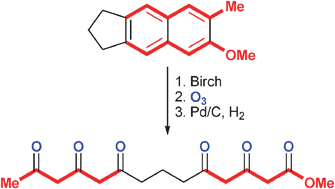Aromatic compounds as synthons for 1,3-dicarbonyl derivatives†
Abstract
This tutorial review covers the applications of

- This article is part of the themed collection: Rapid complexity generation in natural product total synthesis
* Corresponding authors
a
Fachbereich Chemie Philipps-Universität Marburg, Hans-Meerwein-Straße, D-35043 Marburg, Germany
E-mail:
Hilt@chemie.uni-marburg.de
Fax: +49 6421 2825677
Tel: +49 6421 2825601
This tutorial review covers the applications of

 Please wait while we load your content...
Something went wrong. Try again?
Please wait while we load your content...
Something went wrong. Try again?
G. Hilt and D. F. Weske, Chem. Soc. Rev., 2009, 38, 3082 DOI: 10.1039/B902344P
To request permission to reproduce material from this article, please go to the Copyright Clearance Center request page.
If you are an author contributing to an RSC publication, you do not need to request permission provided correct acknowledgement is given.
If you are the author of this article, you do not need to request permission to reproduce figures and diagrams provided correct acknowledgement is given. If you want to reproduce the whole article in a third-party publication (excluding your thesis/dissertation for which permission is not required) please go to the Copyright Clearance Center request page.
Read more about how to correctly acknowledge RSC content.
 Fetching data from CrossRef.
Fetching data from CrossRef.
This may take some time to load.
Loading related content
